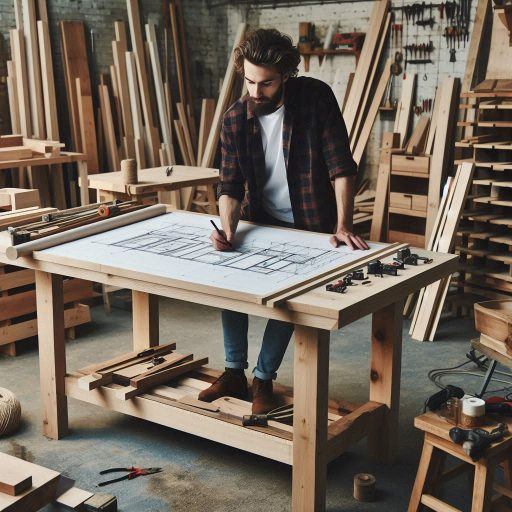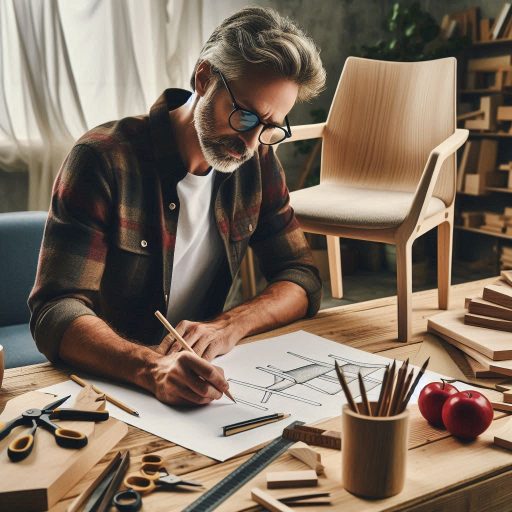Introduction
Managing client expectations in custom furniture design is crucial for achieving project success.
Clear communication helps avoid misunderstandings and ensures that both parties are aligned from the start.
When designers set clear expectations, they create a solid foundation for collaboration, leading to successful projects and satisfied clients.
Understanding client needs and preferences is vital in the custom design process.
By actively listening to clients, designers can deliver tailored solutions that genuinely reflect their vision.
This engagement builds trust and establishes a positive working relationship.
Additionally, establishing timelines and budget constraints early on helps maintain transparency throughout the project.
Effective management of expectations also involves regular check-ins and updates.
Keeping clients informed about progress fosters a sense of involvement and reassurance.
Moreover, it allows designers to address any concerns promptly.
In this blog post, we will discuss strategies for managing client expectations effectively.
We will explore how to communicate clearly, set realistic timelines, and involve clients in the design process.
By following these guidelines, designers can foster positive relationships with clients and ensure successful outcomes for custom furniture projects.
Understanding the client’s vision and requirements:
Successfully managing client expectations in custom furniture design begins with understanding their vision and requirements.
Actively listening to clients is crucial for grasping their needs and preferences.
This foundational step helps you create designs that align with their expectations.
When clients feel heard, they are more likely to engage in the design process and share their ideas openly.
Emphasizing Active Listening
Asking probing questions plays a significant role in clarifying the client’s vision.
These questions help uncover specific details that may not surface in casual conversation.
For instance, inquire about their preferred styles, colors, and materials.
Understanding their lifestyle and the intended use of the furniture can also guide your design choices.
Questions like, “What atmosphere do you want to create?” or “How will you use this piece?” provide valuable insights.
This deeper understanding helps you design furniture that meets both aesthetic and functional needs.
The Significance of Probing Questions
Communication is vital throughout the design process.
Establishing clear channels of communication from the start ensures both parties remain on the same page.
Set expectations regarding how often you will check in with the client.
Regular updates can reassure clients that you are progressing with their vision.
Use visual aids, like sketches or mood boards, to help clients visualize your ideas.
This practice fosters collaboration and allows for adjustments before the final design is set.
The Role of Communication
Encourage clients to share any inspirations or references.
Whether it’s a Pinterest board or images from magazines, these visual cues can guide your design process.
They provide context and help you understand the client’s aesthetic preferences.
This exchange of ideas builds trust and strengthens your working relationship.
Additionally, take notes during meetings to capture important details about the client’s vision.
Summarizing key points and confirming them with the client ensures you accurately understand their requirements.
This practice reduces misunderstandings and keeps everyone aligned.
Being transparent about what is feasible within the project’s scope is essential.
Discuss budget constraints and timelines openly to prevent future surprises.
If certain design elements may not be achievable, address these concerns early.
Offering alternatives can demonstrate your expertise while keeping the client engaged.
Ultimately, understanding the client’s vision and requirements lays the groundwork for a successful custom furniture design project.
Active listening, probing questions, and effective communication all contribute to a positive client experience.
By prioritizing these elements, you can foster a collaborative atmosphere that leads to satisfying outcomes.
When clients feel understood and valued, they are more likely to appreciate your work and recommend your services in the future.
Read: Top Skills Needed for Art Educators and Instructors
Setting realistic timelines and budget constraints
In custom furniture design, setting realistic timelines and budget constraints is critical for managing client expectations.
Establish clear guidelines from the start to ensure both designer and client understand the project’s scope and challenges.
This proactive approach reduces the risk of misunderstandings, keeps the project on track, and helps maintain a positive working relationship.
Setting Clear Timelines
Explaining the necessity of setting clear timelines for the project is crucial in the custom design process.
Clients must understand how long each phase of the design and production will take.
Walk them through the steps involved, such as initial design drafts, material sourcing, prototyping, and manufacturing.
This breakdown allows clients to see the complexity of custom furniture creation and helps them appreciate the time required for each phase.
Discuss potential delays upfront to manage expectations.
Factors like material availability, supply chain disruptions, or changes in the design can impact timelines.
Being transparent about these potential issues prepares the client for any shifts in the schedule.
This proactive communication reduces the likelihood of frustration if delays occur, as the client will already understand the challenges.
Additionally, setting buffer periods is a helpful strategy.
Including extra time between phases for unforeseen issues can prevent the project from becoming rushed or incomplete.
This buffer also gives the client peace of mind, knowing that the project has some flexibility built into the schedule.
Establishing a Realistic Budget
Just as important as the timeline is setting a realistic budget with the client.
Custom furniture often comes with higher costs than mass-produced pieces, due to factors like premium materials, craftsmanship, and personalized designs.
Discussing these costs upfront ensures the client understands the financial investment required for the project.
Start by breaking down the budget into clear components, such as design fees, material costs, and labor.
Offering flexibility within the budget is also essential.
For example, suggest alternative materials or more efficient production techniques that could reduce costs without compromising quality.
This allows the client to make informed decisions based on their priorities, whether it’s budget savings or premium features.
Managing Time and Money Constraints
Effectively managing client expectations regarding time and budget constraints requires continuous communication.
Setting expectations early on is vital, but keeping the client informed throughout the project is equally important.
Provide regular updates on progress, and if any delays or budget adjustments become necessary, inform the client immediately.
For instance, if material costs suddenly rise or a particular component is unavailable, let the client know right away.
Present alternative solutions to keep the project moving forward, whether that involves adjusting the timeline or finding cost-effective substitutes.
Encourage clients to prioritize the most essential elements of the design.
If budget or time constraints become more pressing, suggest focusing on core design features first, with the option to add secondary elements later.
This phased approach ensures that the client gets a high-quality product without feeling pressured to make compromises they may regret.
Read: Collaborating with Other Creative Roles
Providing regular progress updates
Keeping clients informed about the progress of a custom furniture design project is vital for building trust and maintaining strong working relationships.
Regular updates ensure that clients feel involved in the process, reassuring them that their vision is on track.
When clients are kept in the loop, they are more likely to appreciate the work being done and maintain confidence in the final outcome.
This practice also reduces the chances of misunderstandings and last-minute changes, which can disrupt the project’s timeline.
The Benefits of Keeping Clients Informed
Providing regular updates offers several benefits that contribute to the success of a project.
When clients are informed at every stage, they feel more in control and confident that their preferences are being considered.
This involvement builds trust, as clients can see the progress and offer feedback when needed.
Regular updates also help avoid surprises.
If a client’s vision needs to be adjusted due to practical limitations, they are more receptive when they are part of the process.
Updates also give clients the opportunity to request changes early on, which is easier to handle than dealing with revisions after significant work has been completed.
Involving the client from the start ensures that expectations are aligned, reducing the chances of dissatisfaction or the need for extensive revisions later in the project.
Communication Channels for Progress Updates
Various communication channels can be used to keep clients informed throughout the design process.
In-person meetings effectively share detailed updates through hands-on discussions and reviewing prototypes, materials, or sketches.
These meetings offer clients a tangible sense of progress and provide an opportunity to ask detailed questions.
Phone calls are another option, especially for quick updates or when immediate feedback is needed.
These conversations can be more personal than emails, offering a direct and interactive way to clarify details.
However, it’s important to follow up with a written summary to ensure that both parties are aligned.
Emails are useful for regular updates, providing a written record that both the designer and client can reference later.
They also allow the client to review progress at their own pace and provide thoughtful feedback.
Sending images or short videos of the work in progress via email can enhance transparency, giving clients a visual sense of how their furniture is coming together.
Strategies for Open and Transparent Communication
Maintaining open and transparent communication from the start is essential.
Set expectations early by discussing how often updates will be shared and through which channels.
Whether it’s weekly or biweekly, consistency is key to building trust.
If challenges arise or delays occur, it’s crucial to inform the client immediately and provide solutions to address the issue.
This openness fosters a sense of partnership, where the client feels included in the decision-making process.
Clear communication also involves summarizing each update.
After every conversation or meeting, recap key points and confirm the next steps.
This practice ensures clarity and alignment, avoiding any confusion.
Additionally, address any client concerns or questions promptly to keep the project moving smoothly.
Read: Breaking Down Iconic Movie Costumes

Managing design revisions and feedback
Successfully managing design revisions and feedback is key to ensuring client satisfaction in custom furniture design.
Flexibility is crucial when accommodating changes to the design.
While clients often have a clear vision, revisions can arise during the process, requiring an open and adaptable approach.
Embracing these changes ensures that the design continues to evolve while maintaining the client’s trust.
The Need for Flexibility in Design Revisions
Being flexible allows you to respond to the client’s evolving preferences and new ideas.
It’s essential to view revisions as opportunities for refinement rather than obstacles.
Whether it’s a change in materials, dimensions, or aesthetic elements, flexibility in your approach ensures the project progresses smoothly.
Providing quick adjustments helps build confidence in your design skills while aligning more closely with the client’s evolving vision.
Transform Your Career Today
Unlock a personalized career strategy that drives real results. Get tailored advice and a roadmap designed just for you.
Start NowSetting Boundaries and Managing Expectations
While flexibility is important, it’s equally vital to set clear boundaries when it comes to revisions.
Constant changes can lead to delays or budget overruns, so managing expectations upfront is critical.
Discuss how many revisions are included in the project and explain additional costs or timeframes that may result from excessive changes.
This transparent approach helps maintain control over the design process while keeping the client informed and reassured.
Navigating Feedback to Maintain the Client’s Vision
Incorporating client feedback is a natural part of custom furniture design, but balancing it with the original vision can be challenging.
Clients may request revisions that could compromise the functionality or aesthetics of the design.
In these situations, gently steer the conversation toward practical alternatives that preserve the integrity of the original concept.
Offering professional advice while staying receptive to their ideas helps you create a design that satisfies both the client’s preferences and the project’s goals.
Examples of Navigating Design Revisions
For instance, if a client requests to switch to a material that impacts the durability of the furniture, explain the potential drawbacks.
Offer alternatives that achieve a similar look while maintaining quality.
Another example might involve design proportions that affect usability.
If a client suggests changes that could lead to discomfort, communicate why the original design better suits their needs.
This approach demonstrates your expertise and keeps the project aligned with their vision.
Ultimately, managing design revisions and feedback effectively requires a balance of flexibility, clear boundaries, and thoughtful communication.
By accommodating changes, setting realistic expectations, and offering professional guidance, you can navigate revisions without sacrificing the quality of the design.
This approach ensures that the client’s vision is met while maintaining a smooth and collaborative process throughout the project.
Read: Networking Events for Costume Designers
Handling unexpected challenges and changes
In custom furniture design, unexpected challenges or changes are inevitable.
Successfully navigating these obstacles requires clear communication and adaptability.
Addressing issues promptly and managing client expectations ensures the project stays on track, even when faced with unforeseen difficulties.
Addressing Unexpected Challenges
Challenges can arise from various factors, such as material shortages, manufacturing delays, or design adjustments.
It’s important to anticipate that things may not always go as planned.
Rather than avoiding these situations, prepare yourself to address them head-on.
A proactive mindset allows you to respond quickly and minimize disruptions to the project.
Acknowledging that challenges are part of the process helps you stay calm and focused when they occur.
Communicating Challenges to Clients
When challenges arise, effective communication with your client becomes crucial.
Transparency is key.
Keep the client informed about any potential delays or modifications as soon as possible.
Clearly explain the nature of the issue and how it impacts the project.
Clients appreciate honesty, especially when it involves potential setbacks.
By keeping the lines of communication open, you build trust and foster a sense of partnership.
Discuss the problem with the client, offering potential solutions or alternatives to keep the project moving forward.
For example, if a specific material is unavailable, suggest similar options that maintain the design’s integrity.
Providing solutions demonstrates your professionalism and problem-solving abilities, reassuring the client that you have the situation under control.
Managing Client Expectations
Managing client expectations is critical when handling changes or delays.
Be upfront about how these challenges might affect the timeline or final outcome.
Set realistic expectations and avoid overpromising.
Instead, focus on maintaining open dialogue and offering solutions that align with the client’s goals.
This approach ensures both parties remain aligned, even when things don’t go as originally planned.
When discussing delays or modifications, emphasize the importance of maintaining the quality and craftsmanship of the furniture.
Clients are more likely to accept delays if they understand that you are prioritizing the excellence of the final product.
Staying Agile and Adaptable
Agility and adaptability are essential traits for overcoming unforeseen obstacles in custom furniture design.
Remain flexible in your approach and be willing to make adjustments as needed.
Embrace creative problem-solving to find solutions that meet both your design vision and the client’s expectations.
By staying adaptable, you ensure the project progresses smoothly, even when challenges arise.
Flexibility helps you manage changing circumstances and ultimately leads to a more successful outcome.
Handling unexpected challenges with clear communication, proactive solutions, and adaptability ensures a positive client experience, even in difficult situations.
Finalizing the custom furniture design project
Finalizing a custom furniture design project requires careful attention to detail.
It’s essential to follow specific steps, including quality assurance checks and final inspections, to ensure the project meets the highest standards.
By addressing these key areas, you can guarantee that the final product aligns with the client’s vision and requirements.
Quality Assurance Checks and Final Inspections
One of the most critical steps in finalizing a project is conducting thorough quality assurance checks.
These checks help ensure the furniture is crafted to the agreed-upon specifications and is free of defects.
Examining the materials, finishes, and craftsmanship allows you to spot and correct any issues before presenting the final piece to the client.
Final inspections also play a crucial role in delivering a flawless product.
It is essential to review every aspect of the furniture, from the structure to the fine details, to ensure the design functions as intended.
This step prevents any last-minute surprises and guarantees the client receives a product that meets their expectations.
Ensuring Client Satisfaction
Before completing the project, it is essential to ensure the client is fully satisfied with the results.
Conducting a final meeting or presentation to review the finished furniture allows the client to provide feedback.
This is a crucial moment to address any concerns or make final adjustments if necessary.
Prioritizing the client’s satisfaction builds trust and reinforces your commitment to delivering a quality product.
Asking for the client’s input at this stage shows that you value their opinion and are dedicated to meeting their needs.
Offering to make minor tweaks or adjustments demonstrates your willingness to go the extra mile, which can enhance your professional reputation.
Managing the Handover Process
The handover process is another significant step in finalizing a custom furniture design project.
Properly managing this phase ensures a smooth transition from design to delivery.
Clearly communicate the details of the handover, including any maintenance tips or care instructions for the furniture.
This guidance helps clients maintain the piece and extends its longevity.
Additionally, providing documentation related to the project, such as warranty information, is crucial.
This adds a layer of professionalism and ensures the client knows they have post-project support.
Providing Post-Project Support
Offering post-project support is key to maintaining a strong client relationship.
Being available to answer questions or address any concerns after the project completion ensures continued client satisfaction.
Providing this ongoing support builds trust and can lead to future referrals or repeat business.
Finalizing a custom furniture design project requires careful quality checks, client satisfaction, and proper handover management.
This process ensures the successful completion of the project and builds lasting relationships.
Addressing client feedback and reviews
Addressing client feedback and reviews is crucial for the success of any custom furniture design business.
Seeking feedback upon project completion shows clients that you value their opinion and are committed to continuous improvement.
This step helps you learn what worked well and identify areas for growth, ensuring future projects align even more closely with client expectations.
The Importance of Seeking Feedback
Actively requesting feedback allows clients to express their thoughts and feelings about the final product.
This approach strengthens the relationship between you and the client by showing you care about their satisfaction.
Encourage clients to provide both positive and constructive feedback so that you can understand their full experience.
Seeking feedback also provides you with valuable insights into how to improve your design process and client interactions.
Handling Positive and Negative Feedback
Managing feedback, whether positive or negative, requires a thoughtful approach.
Positive feedback is great for affirming your methods and maintaining your business’s reputation.
Thank clients for their kind words and acknowledge how their input has contributed to your success.
This simple act of gratitude fosters long-term client relationships and increases the likelihood of referrals.
On the other hand, handling negative feedback can be more challenging but equally important.
Address any concerns with professionalism and an open mind.
Take time to understand the root of their dissatisfaction and provide solutions when possible.
A calm, respectful response to negative feedback can turn a potentially harmful situation into an opportunity to demonstrate excellent customer service.
This approach also shows that you are committed to continuous improvement and client satisfaction.
The Role of Client Reviews and Testimonials
Client reviews and testimonials play a significant role in building a positive reputation for your custom furniture design business.
Satisfied clients who leave glowing reviews can boost your credibility and attract new customers.
Showcase these reviews on your website, social media, or portfolio to highlight your strengths and the value you bring to your clients.
Encourage clients to share their experiences on review platforms, as this enhances your visibility and trustworthiness in the industry.
Even constructive feedback can help improve your business practices and attract clients who appreciate your dedication to quality.
Addressing client feedback and reviews is essential for growth and success in custom furniture design.
Actively seeking feedback shows you care about client satisfaction, while handling both positive and negative feedback in a constructive manner builds trust.
Client reviews and testimonials further strengthen your reputation, helping your business stand out in the competitive design industry.
Conclusion
Managing client expectations in custom furniture design requires clear communication and setting realistic goals.
Showcase Your Business Today
Reach thousands of readers actively exploring professional services. Publish your business profile and grow your audience now.
Publish NowMaintain transparency throughout every stage of the project to ensure satisfaction.
Actively listening to clients is essential for understanding their vision and aligning your design with their needs.
Asking probing questions and providing regular updates ensures that both parties remain on the same page from start to finish.
Setting realistic timelines and discussing budget constraints early on helps prevent misunderstandings.
Transparency about what’s achievable within the project’s scope builds trust and ensures smooth collaboration.
When clients know exactly what to expect, they feel more confident in the process and are likely to appreciate the final product.
By addressing any concerns promptly and offering solutions, you create a positive experience for clients, ultimately leading to successful outcomes.
Implementing these strategies helps custom furniture designers foster stronger relationships with clients and deliver designs that meet or exceed expectations.
Prioritizing effective communication, realistic goals, and transparency is key to ensuring satisfied clients and a successful custom furniture design business.
Following these practices will help you build lasting client relationships and long-term success.
[E-Books for Sale]
The Big Book of 500 High-Paying Jobs in America: Unlock Your Earning Potential
$19.99 • 500 High-Paying Jobs • 330 pages
Explore 500 high-paying jobs in America and learn how to boost your career, earn more, and achieve success!
See All 500 High-Paying Jobs of this E-Book
1001 Professions Without a Degree: High-Paying American Jobs You Can Start Now
$19.99 • 1001 Professions Without a Degree • 174 pages
Discover 1001 high-paying jobs without a degree! Unlock career tips, skills, and success strategies for just $19.99!




